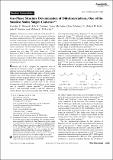| dc.contributor.author | Crabtree, Kyle N. | |
| dc.contributor.author | McCaslin, Laura | |
| dc.contributor.author | Martinez, Oscar | |
| dc.contributor.author | Stanton, John F. | |
| dc.contributor.author | McCarthy, Michael C. | |
| dc.contributor.author | Womack, Caroline C. | |
| dc.contributor.author | Field, Robert W | |
| dc.date.accessioned | 2018-03-27T15:06:37Z | |
| dc.date.available | 2018-03-27T15:06:37Z | |
| dc.date.issued | 2014-03 | |
| dc.date.submitted | 2014-01 | |
| dc.identifier.issn | 1433-7851 | |
| dc.identifier.issn | 1521-3773 | |
| dc.identifier.uri | http://hdl.handle.net/1721.1/114391 | |
| dc.description.abstract | Carbenes are reactive molecules of the form R[superscript 1]-C̈-R[superscript 2] that play a role in topics ranging from organic synthesis to gas‐phase oxidation chemistry. We report the first experimental structure determination of dihydroxycarbene (HO-C̈-OH), one of the smallest stable singlet carbenes, using a combination of microwave rotational spectroscopy and high‐level coupled‐cluster calculations. The semi‐experimental equilibrium structure derived from five isotopic variants of HO-C̈-OH contains two very short CO single bonds (ca. 1.32 Å). Detection of HO-C̈-OH in the gas phase firmly establishes that it is stable to isomerization, yet it has been underrepresented in discussions of the CH[subscript 2]O[subscript 2] chemical system and its atmospherically relevant isomers: formic acid and the Criegee intermediate CH[superscript 2]OO. Keywords: atmospheric chemistry, carbenes, microwave spectroscopy, reactive intermediates, structure elucidation | en_US |
| dc.description.sponsorship | Camille & Henry Dreyfus Foundation (Postdoctoral Fellowship) | en_US |
| dc.description.sponsorship | National Science Foundation (U.S.) (Grant CHE1058063) | en_US |
| dc.description.sponsorship | Robert A. Welch Foundation (Grant F‐1283) | en_US |
| dc.description.sponsorship | United States. Department of Energy. Office of Basic Energy Sciences (Grant DE‐FG02‐07ER15884) | en_US |
| dc.language.iso | en_US | |
| dc.publisher | Wiley Blackwell | en_US |
| dc.relation.isversionof | http://dx.doi.org/10.1002/anie.201311082 | en_US |
| dc.rights | Creative Commons Attribution-Noncommercial-Share Alike | en_US |
| dc.rights.uri | http://creativecommons.org/licenses/by-nc-sa/4.0/ | en_US |
| dc.source | Prof. Field | en_US |
| dc.title | Gas-Phase Structure Determination of Dihydroxycarbene, One of the Smallest Stable Singlet Carbenes | en_US |
| dc.type | Article | en_US |
| dc.identifier.citation | Womack, Caroline C., et al. “Gas-Phase Structure Determination of Dihydroxycarbene, One of the Smallest Stable Singlet Carbenes.” Angewandte Chemie International Edition, vol. 53, no. 16, Apr. 2014, pp. 4089–92. | en_US |
| dc.contributor.department | Massachusetts Institute of Technology. Department of Chemistry | en_US |
| dc.contributor.approver | Field, Robert, W. | en_US |
| dc.contributor.mitauthor | Womack, Caroline C. | |
| dc.contributor.mitauthor | Field, Robert W | |
| dc.relation.journal | Angewandte Chemie International Edition | en_US |
| dc.eprint.version | Original manuscript | en_US |
| dc.type.uri | http://purl.org/eprint/type/JournalArticle | en_US |
| eprint.status | http://purl.org/eprint/status/NonPeerReviewed | en_US |
| dspace.orderedauthors | Womack, Caroline C.; Crabtree, Kyle N.; McCaslin, Laura; Martinez, Oscar; Field, Robert W.; Stanton, John F.; McCarthy, Michael C. | en_US |
| dspace.embargo.terms | N | en_US |
| dc.identifier.orcid | https://orcid.org/0000-0002-7609-4205 | |
| mit.license | OPEN_ACCESS_POLICY | en_US |
